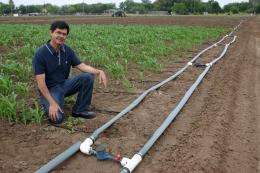Scientist: when it comes to energy crops, do the math

The successful conversion of crops to fuel is all about the math, according to a Texas AgriLife Research scientist.
If the numbers don’t add up, the world is back to square one: fossil fuels, according to Dr. Juan Enciso, an irrigation engineer at the Texas AgriLife Research and Extension Center at Weslaco.
“If we use more fuel than we produce, or if it costs too much to grow energy crops, we’re spinning our wheels,” Enciso said.
Enciso is doing the math, he said, to help all corners of Texas and the Southwest grow energy crops that can produce an efficient and renewable alternative fuel source.
“Lots of crops can be converted to fuel,” he said. “But ideally, to do it successfully, we need to identify energy crops that can be grown on marginal land without irrigation, because water can be an expensive input.”
At an annex farm north of the Weslaco center, Enciso is growing four varieties of energy crops to determine which plants produce the greatest amount of biomass with the least amount of water.
“We’re closely monitoring their growth to compare the efficiency of several crop species: energy sorghum, energy sugarcane and miscanthus, a perennial grass,” Enciso said.
“We want to determine their biomass production levels because different crops have different water needs. We want to identify prolific crops that can be grown throughout Texas and the Southwest using the least amount of water, preferably on dryland fields that depend only on rainfall,” he said.
Data will be collected over a two-year period.
“We planted the energy sorghum and cane crops two weeks ago, then the miscanthus a few days later,” Enciso said. “The sorghum and cane varieties were developed not for the amount of grain or sugar they can produce, but for how quickly they can produce large amounts of biomass, which can be converted to fuel.”
Enciso is one of several team members involved in the project. Others include Dr. Juan Landivar, an AgriLife Research agronomist and director of the AgriLife Research and Extension centers in Corpus Christi and Weslaco; Dr. John Jifon, an AgriLife Research crop physiologist at Weslaco; and Dr. Carlos Fernandez, an AgriLife Research agronomist at the Corpus Christi Center.
“The energy sorghum will be harvested in three months when we’ll be measuring biomass production and the amount of water used,” Enciso said. “Then we’ll let it ratoon, which means making a second crop by leaving the stalks in the ground and letting them regrow.”
Each crop will be grown on six rows, replicated four times, Enciso said. Various amounts of water use, or evapotranspiration, will be evaluated, including no water.
“This study will determine each crop’s yield, dry matter, leaf-area index and their photosynthesis,” Enciso said. “We’ll also monitor soil-water content to determine exactly how much each plant is using.”
The cost of producing the crops grown with varying amounts of water will be determined by Dr. Luis Ribera, an AgriLife Extension economist at the Weslaco Center.
“The sorghum and sugarcane varieties we’re using were developed by AgriLife Research scientists specifically as energy crops. The sorghum variety was developed by Dr. Bill Rooney, a breeder in College Station, and the cane was developed by Dr. Jorge da Silva, a sugarcane breeder in Weslaco,” Enciso said.
Provided by Texas A&M University




















